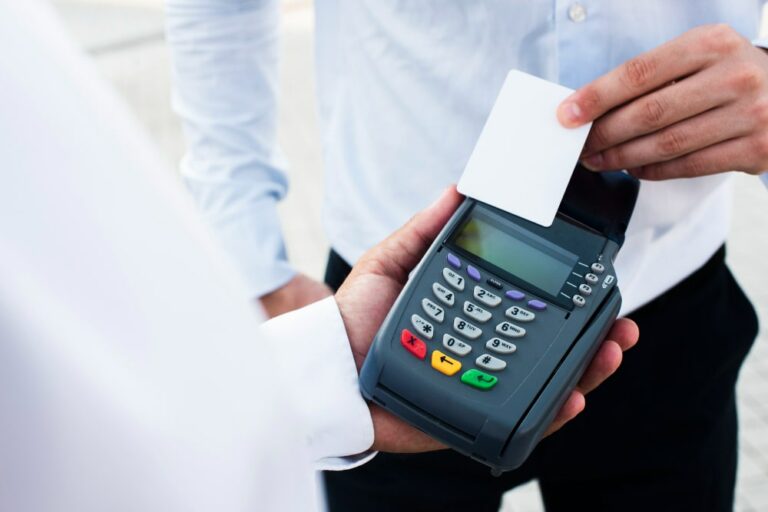In the digital age, online payments have become an integral part of our lives, offering convenience and efficiency like never before. From shopping for groceries to paying bills, the world of e-commerce and digital transactions has revolutionized the way we manage our finances. However, this unprecedented convenience has also given rise to a growing threat – online payment frauds and scams.
As the digital landscape continues to evolve, so do the tactics employed by cybercriminals. Online payment frauds encompass a range of deceptive practices, from phishing schemes that trick you into revealing sensitive information to identity theft that can wreak havoc on your financial well-being. The consequences of falling victim to such scams can be dire, leading to financial losses, emotional distress, and a prolonged battle to reclaim your stolen identity.
But fear not, for this article is your shield in the battle against online payment frauds and scams. We’re about to embark on a journey through the labyrinth of digital security, equipping you with the knowledge and strategies to safeguard your hard-earned money and personal information. So, fasten your virtual seatbelt, as we explore how to fortify your defenses, recognize the warning signs, and ultimately protect yourself from the perils of online payment frauds and scams. Your financial security is our priority, and together, we’ll navigate the digital realm with confidence and resilience.
Recognizing Common Payment Scams:
In the vast online ecosystem, cybercriminals have devised a multitude of cunning payment scams, preying on unsuspecting victims. To protect yourself effectively, it’s crucial to familiarize yourself with these common payment scams and the telltale signs that can help you recognize them:
1. Phishing Attacks:
- Phishing scams involve fraudulent emails, messages, or websites that impersonate trusted entities, like banks or government agencies. Their goal is to trick you into divulging sensitive information, such as login credentials, credit card numbers, or Social Security numbers.
- Warning Signs: Look for spelling and grammatical errors, generic greetings, and email addresses that don’t match the official domain. Be cautious of urgent requests for personal information or unsolicited messages containing suspicious links.
2. Identity Theft:
- Identity theft occurs when cybercriminals steal your personal information, such as your name, address, and Social Security number, to commit fraud or gain unauthorized access to your accounts.
- Warning Signs: Monitor your financial statements regularly for unfamiliar transactions. If you receive notifications about new accounts or credit inquiries you didn’t initiate, investigate promptly.
3. Fake Websites and Apps:
- Scammers create counterfeit websites or mobile apps that mimic legitimate businesses. These deceptive platforms are designed to trick users into making payments or providing personal details.
- Warning Signs: Check for the padlock symbol (indicating a secure connection) and ensure website URLs begin with “https://” when making online payments. Download apps only from trusted sources like official app stores.
4. Overpayment Scams:
- Overpayment scams often target sellers in online marketplaces. Scammers pose as buyers, send a payment exceeding the agreed amount, and request a refund. The initial payment is fake or unauthorized.
- Warning Signs: Exercise caution if a buyer insists on an immediate refund or asks you to send money to a third party. Verify the legitimacy of payments before processing refunds.
5. Advance Fee Fraud:
- In advance fee fraud, scammers promise lucrative deals, such as job opportunities, loans, or prizes, in exchange for an upfront payment. Once they receive the fee, they vanish without delivering on their promises.
- Warning Signs: Be skeptical of unsolicited offers that require upfront payments. Research the company or individual making the offer and refrain from sending money to unfamiliar entities.
6. Tech Support Scams:
- Tech support scammers pose as reputable tech support representatives and claim that your device is infected with malware or experiencing technical issues. They may request payment for fake repairs or services.
- Warning Signs: Legitimate tech support companies will never cold-call or ask for payment via unsolicited calls or pop-up messages. Avoid providing remote access to your device unless you initiated the contact.
Recognizing these common payment scams and their associated warning signs is the first step in fortifying your defenses against online fraud. Stay vigilant, exercise caution when sharing personal information or making payments online, and remember that a healthy dose of skepticism can go a long way in thwarting cybercriminals’ schemes.
Secure Online Payment Practices:
In an era where digital transactions are the norm, adopting secure online payment practices is paramount to protect your financial well-being. Here’s a comprehensive guide on how to navigate the digital landscape safely and ensure that your online payments remain secure:
1. Strong, Unique Passwords:
- Start with the basics. Create strong and unique passwords for all your online accounts, including those related to banking, e-commerce, and email.
- Best Practices: Utilize a combination of letters, numbers, and special characters. Avoid easily guessable information like birthdays or common words. Consider using a reputable password manager to generate and store complex passwords securely.
2. Two-Factor Authentication (2FA):
- Implement 2FA wherever possible. This adds an extra layer of security by requiring you to provide a second form of verification beyond your password.
- Best Practices: Enable 2FA for your email, financial, and social media accounts. Common 2FA methods include receiving a one-time code via text message or using a dedicated authentication app.
3. Antivirus Software and Updates:
- Ensure your devices are equipped with up-to-date antivirus software and operating system updates.
- Best Practices: Regularly update your device’s operating system and antivirus software to patch vulnerabilities and protect against malware and viruses.
4. Recognize Secure Websites:
- When making online payments, verify that you’re on a secure website. Look for the padlock symbol in the address bar and ensure the URL starts with “https://” instead of “http://.”
- Best Practices: Avoid entering payment information on websites that lack these security indicators. Stick to reputable online stores and payment gateways.
5. Safe Wi-Fi Usage:
- Exercise caution when using public Wi-Fi networks for online payments, as they may not be secure.
- Best Practices: Whenever possible, use a secure and private network for online transactions. If you must use public Wi-Fi, consider using a virtual private network (VPN) for added security.
6. Regularly Review Transactions:
- Keep a close eye on your financial statements and transactions.
- Best Practices: Review your bank and credit card statements regularly for unfamiliar or unauthorized transactions. Report any discrepancies to your financial institution immediately.
7. Logout and Clear Browser Data:
- After making online payments or accessing financial accounts, log out of your accounts and clear your browser’s cache and cookies.
- Best Practices: This practice ensures that sensitive information isn’t stored on your device, reducing the risk of unauthorized access.
8. Beware of Email Scams:
- Stay vigilant against phishing emails that attempt to trick you into revealing personal information.
- Best Practices: Be cautious of unsolicited emails, especially those requesting sensitive information or containing suspicious links. Verify the authenticity of emails from financial institutions before taking action.
By following these secure online payment practices, you can significantly reduce the risk of falling victim to online payment frauds and scams. Remember that prevention is key, and taking proactive measures to protect your financial information is a wise investment in your digital security.
Safeguarding Personal Information:
Protecting your personal information is a cornerstone of online security. Cybercriminals often target sensitive data like Social Security numbers, birthdates, and addresses to commit fraud or gain unauthorized access to accounts. Here are essential steps for safeguarding your personal information:
1. Limit Information Sharing:
- Be cautious about sharing personal information, both online and offline.
- Best Practices: Minimize the details you share on social media platforms and public forums. Never disclose sensitive information, such as your full birthdate or Social Security number, unless absolutely necessary.
2. Privacy Settings:
- Adjust privacy settings on your social media accounts and devices to control who can access your personal information.
- Best Practices: Regularly review and update your privacy settings on social media platforms to restrict access to your personal details. Limit the visibility of your profile to only trusted connections.
3. Secure Physical Documents:
- Safeguard physical documents that contain sensitive information.
- Best Practices: Store important documents, such as passports, driver’s licenses, and financial statements, in a secure and locked location. Shred documents you no longer need before disposing of them.
4. Use Strong PINs and Passcodes:
- Protect your devices and accounts with strong PINs and passcodes.
- Best Practices: Create PINs and passcodes that are not easily guessable. Avoid using common patterns like “1234” or “password.” Use longer passphrases with a combination of letters, numbers, and special characters.
5. Secure Digital Files:
- Encrypt sensitive digital files to prevent unauthorized access.
- Best Practices: Utilize encryption software to secure important files on your computer and mobile devices. Encrypt email communications when sharing sensitive information.
6. Secure Personal Devices:
- Protect your smartphones, tablets, and computers from unauthorized access.
- Best Practices: Set up device locks, such as PINs, patterns, or biometric authentication (fingerprint or facial recognition). Ensure that your devices are password-protected, and activate remote tracking and wiping features.
7. Be Cautious with Wi-Fi:
- Exercise caution when connecting to public Wi-Fi networks.
- Best Practices: Avoid accessing or sharing personal information while connected to public Wi-Fi. Use a VPN to create a secure tunnel for your data when browsing on public networks.
8. Safe Document Disposal:
- Dispose of documents containing personal information securely.
- Best Practices: Shred or use a cross-cut shredder for documents like bank statements, credit card offers, and medical bills before discarding them. Avoid tossing them in the trash where they can be easily retrieved.
9. Beware of Social Engineering:
- Description: Be cautious of unsolicited requests for personal information.
- Best Practices: Verify the legitimacy of any requests for personal information, especially over the phone or email. Don’t provide sensitive data unless you are certain of the requester’s identity and purpose.
By implementing these practices, you can fortify your defenses against the theft or misuse of your personal information. A proactive approach to safeguarding your personal details is an essential aspect of maintaining online security and protecting your financial well-being.
Educating Yourself and Others:
In the ongoing battle against online payment frauds and scams, knowledge is your most potent weapon. Staying informed about the latest tactics employed by cybercriminals is crucial to maintaining your online security. Additionally, spreading awareness and educating others about safe online practices can collectively strengthen the defenses of the digital community. Here’s how you can educate yourself and contribute to a safer online environment:
1. Stay Informed:
- Regularly educate yourself about the latest scams, fraud techniques, and cybersecurity trends.
- Best Practices: Follow reputable cybersecurity blogs, news outlets, and government websites that provide up-to-date information on emerging threats. Knowledge empowers you to recognize potential scams and protect yourself.
2. Share Information:
- Be proactive in sharing information about scams and fraud with friends and family.
- Best Practices: Share articles, tips, and resources on social media and in your personal networks. Encourage loved ones to stay vigilant and informed about online threats.
3. Community Awareness:
- Contribute to community awareness by organizing or participating in workshops, webinars, or discussions on online security.
- Best Practices: Collaborate with local organizations, schools, or community centers to raise awareness about online payment frauds and scams. Offer practical guidance on how to recognize and avoid scams.
4. Report Suspicious Activity:
- Encourage individuals to report suspicious activity and scams promptly.
- Best Practices: Share information about reporting scams to relevant authorities, such as local law enforcement, the Federal Trade Commission (FTC), or the Cybercrime division. Reporting can aid in shutting down fraudulent operations.
5. Promote Strong Passwords:
- Stress the importance of strong, unique passwords.
- Best Practices: Promote the use of password managers to generate and store complex passwords. Share tips on creating strong passphrases and the significance of not using the same password for multiple accounts.
6. Stay Skeptical:
- Encourage healthy skepticism when encountering unsolicited offers or requests for personal information.
- Best Practices: Remind others that it’s okay to question the legitimacy of unexpected emails, calls, or messages. Emphasize that legitimate organizations won’t pressure individuals into sharing sensitive information.
7. Online Safety for Children:
- Educate children about online safety to protect them from online threats.
- Best Practices: Teach kids about the risks of sharing personal information online, the importance of not interacting with strangers, and the need to report any suspicious online encounters to a trusted adult.
8. Government Resources:
- Point individuals to government resources that provide information on online security.
- Best Practices: Share links to government websites, such as the FTC’s “Consumer Information” page or local law enforcement agencies’ cybercrime divisions, where individuals can find valuable information and resources.
By actively engaging in education and awareness efforts, you not only protect yourself but also contribute to a safer online community. The collective knowledge and vigilance of individuals can make a significant impact in thwarting the efforts of cybercriminals and reducing the prevalence of online payment frauds and scams.
Reporting and Taking Action:
In the event that you encounter suspicious online payment activity or become a victim of fraud, taking immediate action is crucial. Reporting such incidents not only helps protect your financial well-being but also contributes to the larger effort to combat online payment frauds and scams. Here’s how to report and take action effectively:
1. Prompt Reporting:
- Report any suspicious activity or suspected fraud as soon as you become aware of it.
- Best Practices: Contact your financial institution, such as your bank or credit card provider, to report unauthorized transactions. Timely reporting can lead to a faster resolution.
2. Document Everything:
- Keep detailed records of all communications and transactions related to the suspected fraud.
- Best Practices: Take screenshots of suspicious emails, messages, or websites. Document dates, times, and the names of any individuals you communicate with regarding the incident.
3. Notify Law Enforcement:
- Report online payment fraud to your local law enforcement agency.
- Best Practices: File a police report detailing the fraudulent activity. Provide any evidence you’ve gathered, such as screenshots or copies of suspicious messages.
4. Contact Credit Bureaus:
- Place a fraud alert or credit freeze with credit reporting agencies.
- Best Practices: Contact Equifax, Experian, and TransUnion to request a fraud alert or credit freeze on your accounts. This adds an extra layer of protection against identity theft.
5. Notify Relevant Authorities:
- Report the incident to appropriate regulatory authorities.
- Best Practices: If you’ve fallen victim to a scam, file a complaint with the Federal Trade Commission (FTC) or your country’s equivalent consumer protection agency. Reporting scams helps law enforcement track and combat fraudulent activities.
6. Online Platform Reporting:
- If the fraud occurred on an online platform or marketplace, report it through the platform’s official channels.
- Best Practices: Use the platform’s reporting feature to document and report fraudulent transactions or interactions. Many platforms have dedicated fraud reporting systems.
7. Secure Your Accounts:
- Take steps to secure your compromised accounts.
- Best Practices: Change passwords and enable two-factor authentication (2FA) on accounts that may have been affected. Review and update security settings.
8. Monitor Your Credit:
- Keep a close eye on your credit reports.
- Best Practices: Regularly review your credit reports for any suspicious or unauthorized activity. Dispute any inaccuracies or fraudulent entries with credit reporting agencies.
9. Stay Informed:
- Stay informed about the status of your case and any developments related to the incident.
- Best Practices: Maintain communication with your financial institution, law enforcement, and regulatory authorities. Follow up on your case regularly to ensure it’s being investigated.
Taking swift and thorough action when you encounter online payment fraud is essential to minimize financial losses and protect your identity. Reporting these incidents not only helps you but also contributes to the collective effort to combat cybercrime and protect others from falling victim to scams and frauds.




